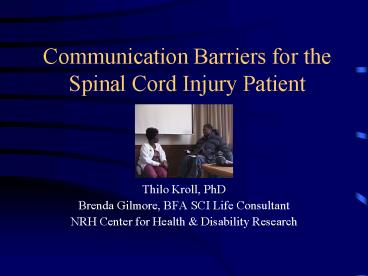Communication Barriers for the Spinal Cord Injury Patient - PowerPoint PPT Presentation
1 / 26
Title:
Communication Barriers for the Spinal Cord Injury Patient
Description:
Use a normal tone of voice when extending a verbal welcome. ... When offering help with bags or carrying items inquire whether you may help ... – PowerPoint PPT presentation
Number of Views:157
Avg rating:3.0/5.0
Title: Communication Barriers for the Spinal Cord Injury Patient
1
Communication Barriers for the Spinal Cord Injury
Patient
- Thilo Kroll, PhD
- Brenda Gilmore, BFA SCI Life Consultant
- NRH Center for Health Disability Research
2
Goals
- To identify communication issues and needs when
interacting with people with SCI and other
disabilities - To determine critical communication skills
- To identify strategies to improve communication
with individuals who have disabilities
3
The Consumer-Professional Partnership Program
- Consumers co-present in education settings for
health care professionals - The SCI Life Educator Concept
- Training Manual
- 3 Core Modules Disability Awareness and
Communication Prevention of Secondary
Conditions, Physical Activity and Exercise
4
Definition Communication
- The act of communicating transmission.
- The exchange of thoughts, messages, or
information, as by speech, signals, writing, or
behavior. - Interpersonal rapport.
The American Heritage Dictionary of the English
Language, Fourth Edition 2004 Houghton Mifflin
5
Why communication?
- Rapport building
- Accuracy in exchange of information
- Receptiveness of information
- Cooperation in treatment and rehabilitation
- Prevention of secondary conditions and medical
complications - General respect
6
Types of Communication Barriers
- Physical/Individual
- Attitudes and Behaviors
- Environmental
7
Physical
- Changes in the ability to communicate verbally
- Changes in communication due to functional
limitations (use of arms) and body position
(wheelchair)
8
Attitudes and Behaviors
- Halo-Effect Physical limitations in specific
functions are interpreted in terms of limitations
of the person - Confounding physical, cognitive and linguistic
abilities - Stereotyping
- Lack of knowledge about SCI
- Lack of attention to issues other than SCI
- Preventive screenings, sexuality, exercise,
wellness
9
Environmental Barriers
- Transportation
- Availability
- Timeliness
- Cost
- Office accessibility
- Parking
- Elevators and doorways
- Examination rooms
- Diagnostic Equipment
- Staff communication
10
Strategies for Addressing Communication Barriers
11
Physical
- Be patient!
- Hold eye contact
- Explore alternative ways to verbal communication
- When speaking to a relative, acknowledge the
patient through eye contact and direct address - Dont forget to respectfully acknowledge
individual as a person first with a unique
biography, personal interests, needs and skills
12
Attitudes and behaviors
- Person with a disability is a person first, a
patient second, and an individual with special
needs third - Dont make assumptions or jump to quick
conclusions about the reasons they come to see
you - Approach the individual with a disability just
like everyone else
13
Attitudes and Behaviors (continued)
- Dont make assumptions about the social life of
people with disabilities - Do not automatically provide assistance
- Make sure you look at and talk directly to the
person with a disability
14
Environment
- Be flexible in time allotted for appointments
- Tardiness may be beyond patients control due to
transportation, assistance issues
- Make office experience as easy as possible for
patient in a wheelchair - Provide information on office layout and
available support - Inquire about assistance needs
15
Communication Ground Rules
16
Introductions and General Communication Rules
- Use a normal tone of voice when extending a
verbal welcome. Do not raise your voice unless
requested. - When introduced to a person with a disability, it
is appropriate to offer to shake hands.
17
Ground Rules (continued)
- Shaking hands with the left hand is acceptable.
- For those who cannot shake hands, touch the
person on the shoulder or arm to welcome and
acknowledge their presence.
18
Ground Rules (continued)
- Treat adults in a manner befitting adults
- When addressing a person who uses a wheelchair,
never lean on the person's wheelchair since the
chair is part of his or her personal space - When talking with a person with a disability,
look at and speak directly to that person and not
through a personal assistant or family
19
Ground Rules (continued)
- Offering assistance
- Introduce yourself and offer assistance.
- Don't be offended if your assistance is not
needed. Dont proceed with assistance! - Ask how you can help and follow instructions.
- Be courteous, but NOT condescending.
- Assist when necessary or requested, but do not
discourage their active participation
20
Ground Rules (continued)
- When offering help with bags or carrying items
inquire whether you may help - Do not hand a cane or crutches unless the
individual requests this.
21
Use of Terminology
22
Use of appropriate terminology
- Awareness of language and terminology is critical
for the development of a trusting relationship
between the individual with a disability and the
healthcare provider - In the medical community it is not uncommon to
identify people by their condition as if that
constitutes their whole identity.
23
Terminology
24
Working with Peers
25
Working with peers
- To develop a better understanding of disability
- To establish a bridge to the community
- To provide effective social role models
- To identify communication and social issues that
challenge rehabilitation efforts - Example NRH SCI Peer Mentor Program
26
Conclusion
- Patients and health care professionals benefit
from open, continuous, and respectful
communication - For further information on the Consumer-Profession
al Partnership Program visit our website
www.sci-health.org/cppp - Contact Brenda.Gilmore_at_medstar.net
- Thilo.Kroll_at_medstar.net































